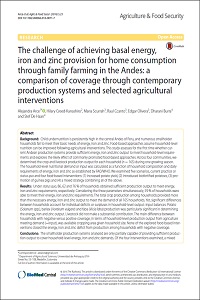Background
Child undernutrition is persistently high in the central Andes of Peru, and numerous smallholder households fail to meet their basic needs of energy, iron and zinc. Food-based approaches assume household-level nutrition can be improved following agricultural interventions. This study assesses for the first time whether current Andean production systems provide sufficient energy, iron and zinc output to meet household-level requirements and explores the likely effect of commonly promoted food-based approaches. Across four communities, we determined the crop and livestock production output for each household (n = 165) during one growing season. The household-level nutritional demand or input was calculated as a function of household composition and daily requirements of energy, iron and zinc as established by FAO/WHO. We examined five scenarios, current practice or status quo and four food-based interventions: (1) increased potato yield, (2) introduced biofortified potatoes, (3) promotion of guinea pigs and (4) a mixed strategy combining all of the above.
Results
Under status quo, 86, 62 and 76 % of households obtained sufficient production output to meet energy, iron and zinc requirements, respectively. Considering the three parameters simultaneously, 59 % of households were able to meet their energy, iron and zinc requirements. The total crop production among households provided more than the necessary energy, iron and zinc output to meet the demand of all 165 households. Yet, significant differences between households account for individual deficits or surpluses in household-level output–input balances. Potato (Solanum spp.), barley (Hordeum vulgare) and faba (Vicia faba) production was particularly significant in determining the energy, iron and zinc output. Livestock did not make a substantial contribution. The main difference between households with negative versus positive coverage, in terms of household-level production output from agriculture meeting demand (=input), was available cropping area given household size. None of the explored food-based interventions closed the energy, iron and zinc deficit from production among households with negative coverage.
Conclusions
The smallholder production systems analyzed are only partially capable of providing sufficient production output to cover household-level energy, iron and zinc demands. Of the four interventions examined, a mixed strategy holds most potential for reducing nutrition gaps. Particularly potato yield increases had a positive effect. The carrying capacity of high-altitude Andean farming systems is strained for households with limited land. Food-based approaches to nutrition under scenarios similar to those reported in this study are advised to balance agricultural interventions with options to enhance off-farm access to food.

